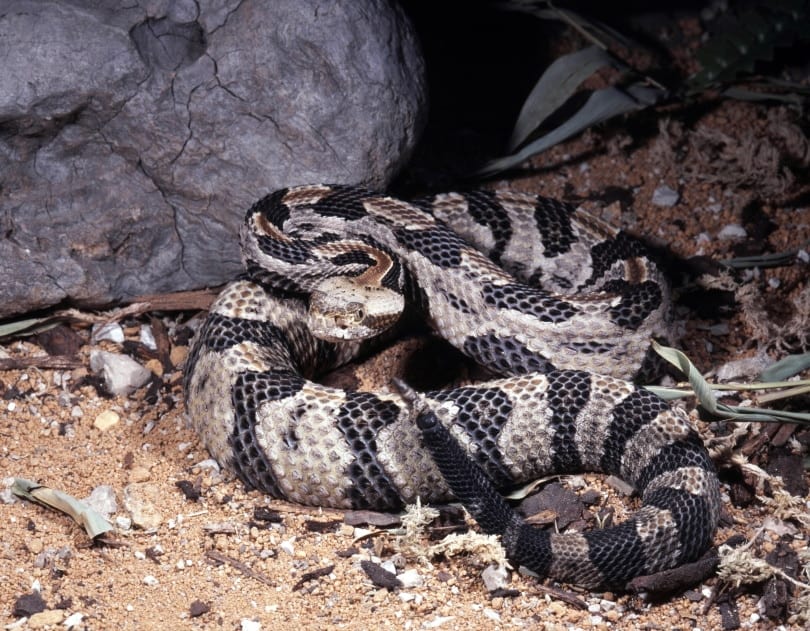Tennessee is home to many different snake species. Most of them are quite harmless, like the Worm Snake. Others are venomous, though.
Venomous snakes in Tennessee include species like the cottonmouth, copperhead, and several different rattlesnakes.
Many of these species are localized to specific areas of Tennessee. For instance, the cottonmouth is only in the western-most part of the state. They typically don’t extend past Nashville.
If you live in Tennessee or plan on visiting, identifying snakes is important. Some non-venomous snakes look quite similar to venomous ones.
Here, we review the most common snakes found in Tennessee.

The 13 Snakes Found in Tennessee
1. Western Cottonmouth
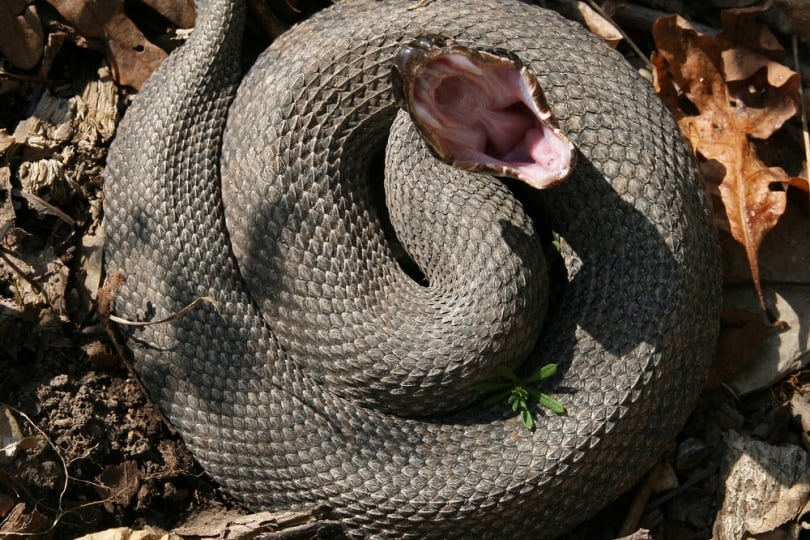
| Species: | Agkistrodon piscivorus |
| Longevity: | Less than 10 years |
| Good to own as a pet?: | No |
| Legal to own?: | No |
| Adult size: | 30–42 inches |
| Diet: | Frogs, fish, salamanders, lizards, birds, and other snakes |
There is only one subspecies of cottonmouth found in Tennessee: the western cottonmouth. This subspecies isn’t found throughout all of Tennessee, just in the most western third of the state. They are most common in Realfoot Lake and the surrounding spots.
They are not aggressive, despite some of the misconceptions. In fact, they usually only bite defensively.
This is one of the most well-known water snakes found in Tennessee. They hang out around swamps and similar areas.
2. Wormsnake
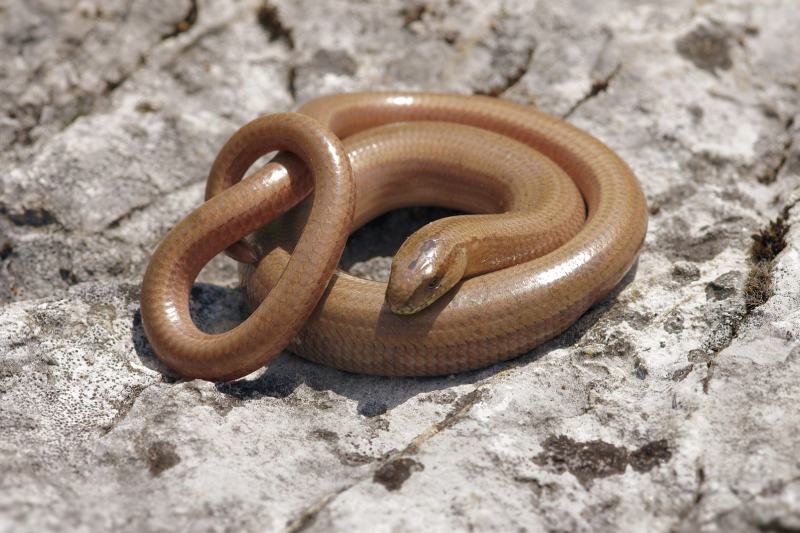
| Species: | Carphophis amoenus |
| Longevity: | About 4 years |
| Good to own as a pet?: | No |
| Legal to own?: | Yes |
| Adult size: | 7.5–11 inches |
| Diet: | Earthworms and other insects |
There are two subspecies of wormsnake that live in Tennessee. As their name suggests, these snakes mostly prey on worms. They are completely harmless and docile toward people.
They have a small head and a short, pointed tail.
Typically, they hide under rocks, rotten wood, and leaves. They prefer hardwood forests and try to remain underground as much as possible. They are extremely secretive snakes and are not spotted often by people.
3. Copperhead
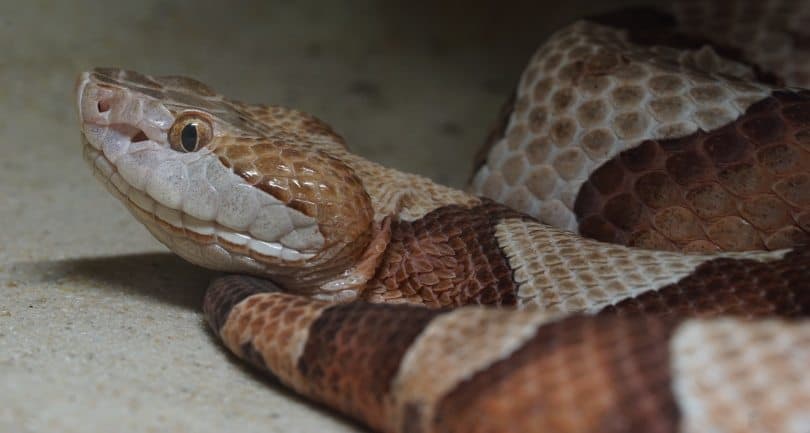
| Species: | Agkistrodon contortrix |
| Longevity: | About 4 years |
| Good to own as a pet?: | No |
| Legal to own?: | No |
| Adult size: | 24–36 inches |
| Diet: | Mice, birds, lizards, insects, and other snakes |
Copperheads are among the most common venomous snakes in Tennessee. They live throughout the whole state but are mostly found in forested areas. They do not like open areas, like pastureland.
There are four subspecies of copperheads, but only two are found in Tennessee: the southern copperhead and northern copperhead.
This heavy-bodied snake has a significantly large head. Like most venomous snakes, their heads are quite triangular. They also have distinctive hourglass-shaped markings across their body, which are the main way that they are identified when stumbled upon.
Milksnakes have similar markings, but they are much smaller, with a tiny head.
4. Timber Rattlesnake
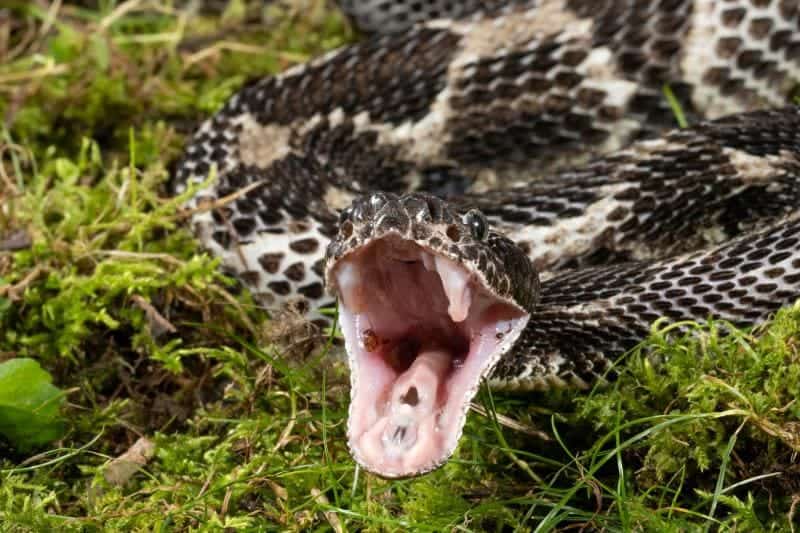
| Species: | Crotalus horridus |
| Longevity: | 10–25 years |
| Good to own as a pet?: | No |
| Legal to own?: | No |
| Adult size: | 36–60 inches |
| Diet: | Small rodents and the occasional bird or lizard |
This rattlesnake species is a venomous snake found in Tennessee.
They are a large snake, both in terms of length and width. They have a substantial, triangular head. Their body coloration is extremely variable and is not considered a consistent way to identify them.
They are found mostly in heavily wooded forests. They prefer south-facing hillsides with plenty of rocks for them to hide in. However, they can be found in mountainous areas, swamps, wooded streams, and rural structures.
Their population is currently on the decline due to habitat loss and persecution.
Due to their rattle, they are considered less dangerous than other venomous snakes. They typically only bite when continually threatened.
5. Scarletsnake

| Species: | Cemophora coccinea |
| Longevity: | Unknown |
| Good to own as a pet?: | No |
| Legal to own?: | Yes |
| Adult size: | 14–20 inches |
| Diet: | Mostly eggs and other reptiles |
The scarletsnake is spread throughout most of the state. They are extremely secretive, which makes the information that we have about them rather scarce. We don’t know much about their lifespan or breeding behavior, for instance. We don’t even know how many there are in Tennessee.
As their name suggests, they have distinctive red colorations, as well as white-and-black markings.
They live in pine and hardwood forests, preferring sandy and loamy soils so they can burrow. They can be found under logs and other debris.
6. Common Kingsnake
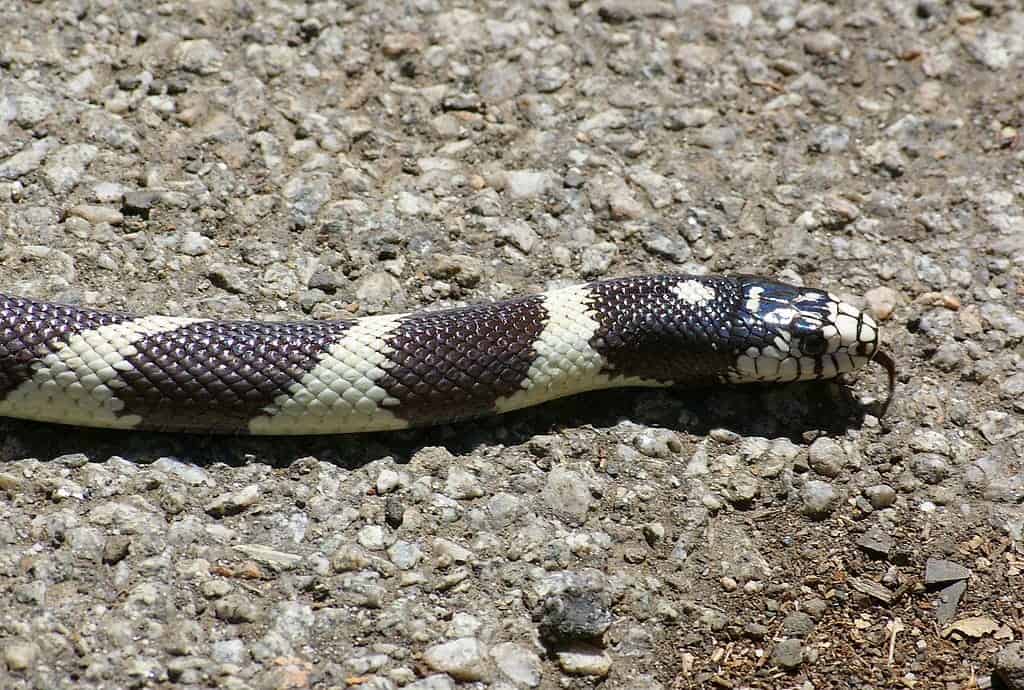
| Species: | Lampropeltis getula |
| Longevity: | 20–30 years |
| Good to own as a pet?: | No |
| Legal to own?: | Yes |
| Adult size: | 36–48 inches |
| Diet: | Rodents, mammals, birds, and other snakes |
The kingsnake is widespread across much of the state. There are three main subspecies found in the state, though one is only found in the southeastern edge of Tennessee.
This snake is black with yellow-tan spotting along their sides and belly. Some even have yellowish crossbands on their backs. They have a “salt and pepper” look.
All kingsnake species can live just about anywhere. They are found in forests, fields, and shrubby areas. They prefer wetlands, but they can be found in any habitat.
They are well-known for their ability to consume venomous snakes, enabling them to play a crucial role in controlling venomous snake populations.
7. Plain-Bellied Watersnake
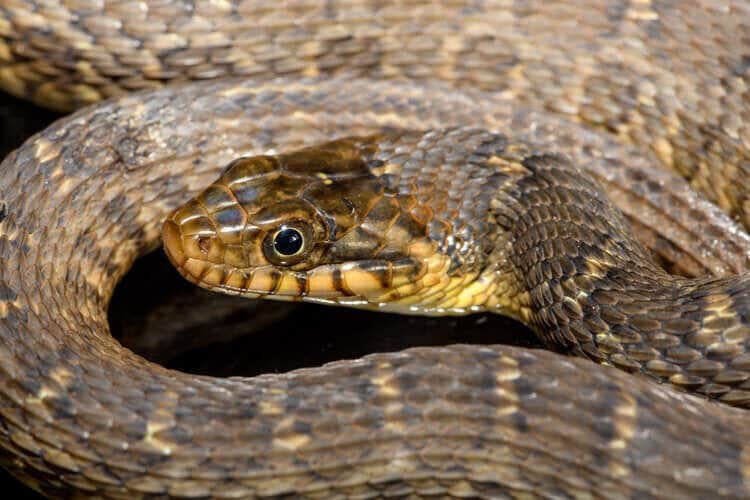
| Species: | Nerodia erythrogaster |
| Longevity: | Unknown in the wild |
| Good to own as a pet?: | No |
| Legal to own?: | Yes |
| Adult size: | 30–48 inches |
| Diet: | Frogs, toads, tadpoles, and salamanders |
There are two subspecies of plain-bellied watersnake in Tennessee: the yellow-bellied watersnake and copper-bellied watersnake.
These medium-sized snakes are commonly mistaken for cottonmouths and needlessly killed. However, they look quite different. With basic knowledge, it is easy to tell them apart.
Usually, these snakes prefer quiet pools of water, such as lakes and wetlands. They usually eat small prey animals that are common around water, such as frogs and salamanders. They will occasionally eat fish.
The copper-bellied watersnake is considered rare and vulnerable in Tennessee.
8. Milksnake
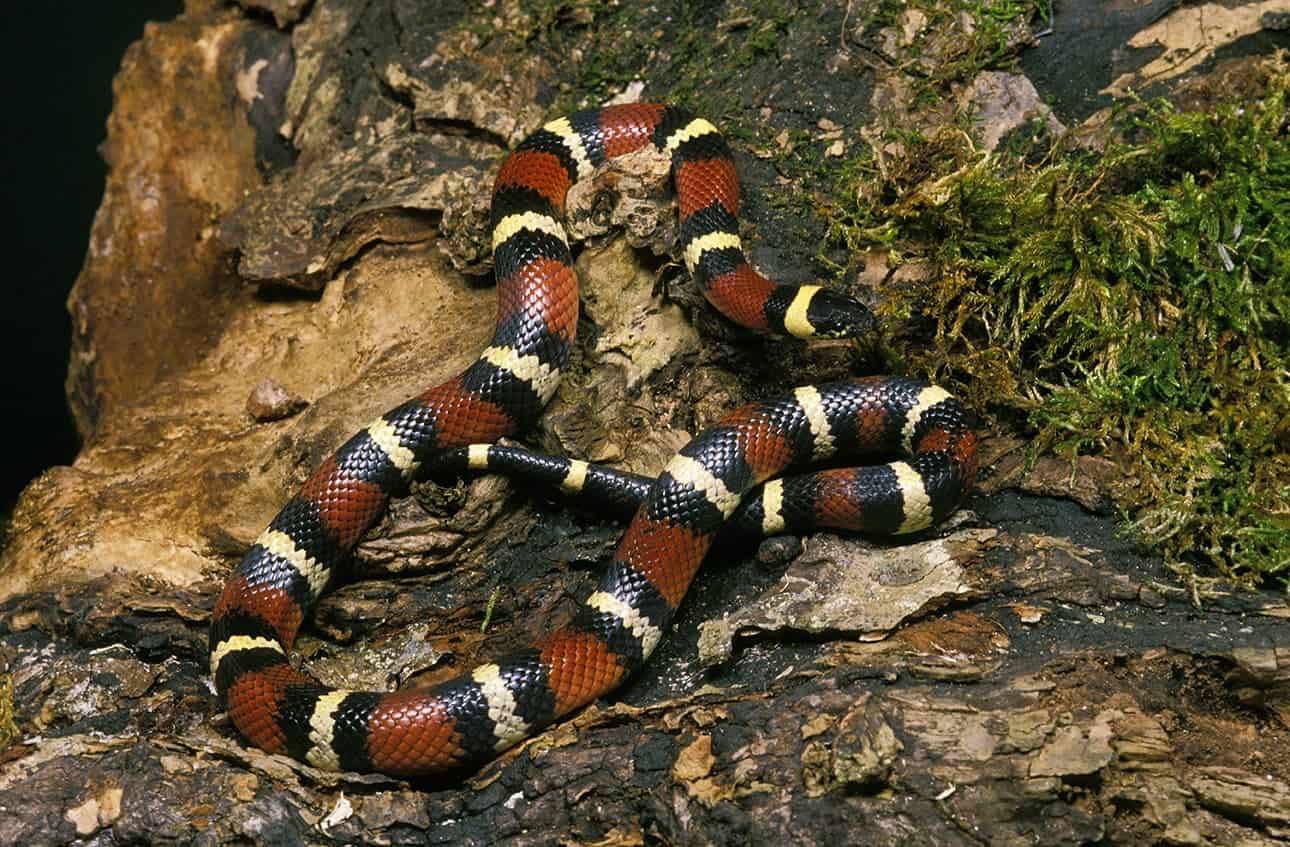
| Species: | Lampropeltis triangulum |
| Longevity: | Unknown in the wild |
| Good to own as a pet?: | Yes |
| Legal to own?: | Yes |
| Adult size: | Varies (14–36 inches) |
| Diet: | Mice, shrews, and voles |
This brightly-colored snake has red-brown blotches bordered by black and separated by white stripes. They do not have the hourglass shape of copperheads, making it easy to tell them apart. Their head is also small, nothing like the larger heads of venomous snakes.
There are multiple subspecies found in Tennessee, with many of them overlapping.
They are found in many different habitats, including pine and hardwood forests. They prefer rock outcroppings and live under debris where possible.
9. Coachwhip

| Species: | Masticophis flagellum |
| Longevity: | 15 years or more |
| Good to own as a pet?: | No |
| Legal to own?: | Yes |
| Adult size: | 42–60 inches |
| Diet: | Lizards, snakes, small mammals |
Known for their lightning-fast speeds, the coachwhip is mostly harmless toward people. They are not venomous but are more prone to biting than other snakes. They are not commonly kept as pets for this reason. Most people simply don’t want to get bitten.
They prefer open habitats, unlike most other Tennessee snakes. They can be found across old fields and farmland.
They range from dark brown to black. Usually, they don’t have many markings. Their head area is usually the darkest, and they may lighten closer to their tail. Very young snakes may have crossbands.
10. Ring-Necked Snake
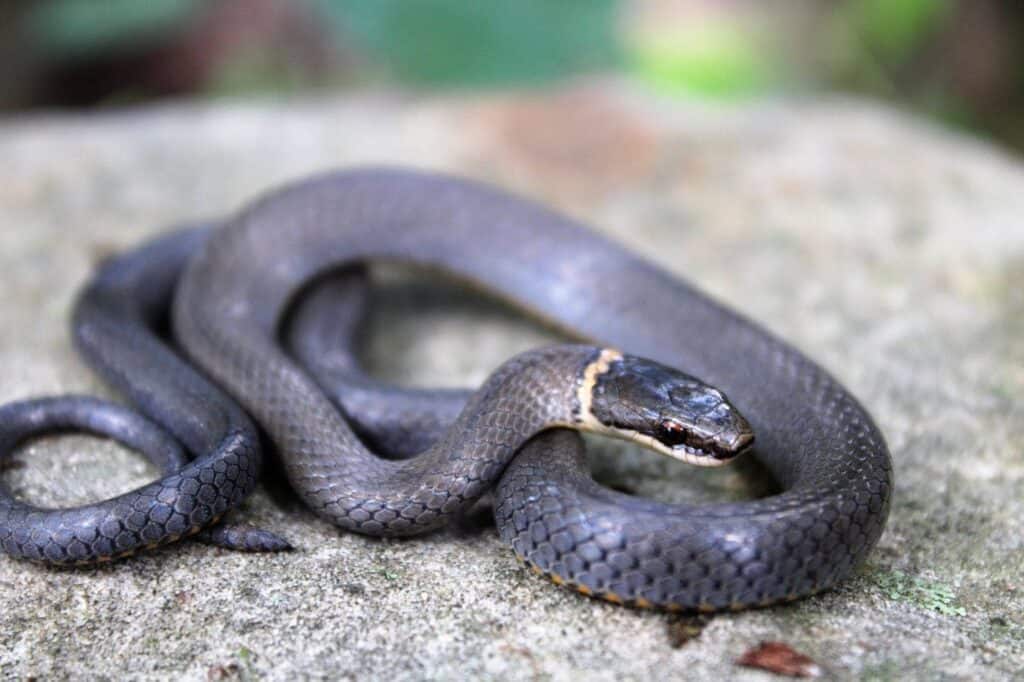
| Species: | Diadophis punctatus |
| Longevity: | 10–15 years |
| Good to own as a pet?: | Yes |
| Legal to own?: | Yes |
| Adult size: | 10–15 inches |
| Diet: | Earthworms, insects, and small lizards |
The ring-necked snake is one of the smallest in Tennessee, growing to 15 inches max.
They tend to prefer moist woodlands, though they can be found in just about any habitat. They spend much of their time hidden under rocks and leaf litter. Their diet consists of earthworms and smaller lizards.
This snake is quite common, but they spend much of their time hidden. They avoid people and typically aren’t sighted unless their hiding area is disturbed.
As their name suggests, they have a lighter-colored ring around their neck. This feature makes them easy to identify.
11. Red Cornsnake

| Species: | Pantherophis guttatus |
| Longevity: | 6–8 years |
| Good to own as a pet?: | Yes |
| Legal to own?: | Yes |
| Adult size: | 30–48 inches |
| Diet: | Small rodents |
The Red Cornsnake is rather long and slender. Their coloration varies widely from orange-brown to dark brown. They are mostly identified by their reddish coloration and red blotches.
Their head is rather small, which sets them apart from many of the venomous snakes found in Tennessee.
They aren’t picky about their habitat. They can be found in fields, farms, suburban lawns, and wooded lots. They are not as secretive as other snakes, making sightings more common. However, they are nocturnal and spend much of their time in rodent burrows.
They constrict their prey when hunting, but they are much too small to hurt humans, even smaller children.
12. Eastern Hog-nosed Snake
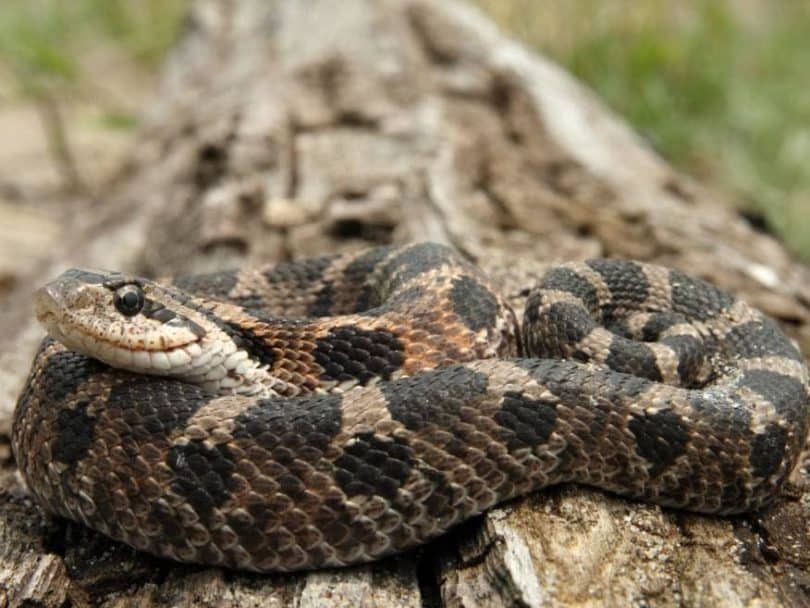
| Species: | Heterodon platirhinos |
| Longevity: | About 12 years |
| Good to own as a pet?: | Yes |
| Legal to own?: | Yes |
| Adult size: | 20–33 inches |
| Diet: | Mostly toads and frogs |
This hog-nosed snake is common across Tennessee. However, they are often needlessly killed because of their strange defensive behavior.
When threatened, they will flatten their head, hiss loudly, and pretend to strike. They also may roll over and play dead or release musk. They have one of the most elaborate defensive techniques of any Tennessee snake.
They like to burrow and prefer sandy and loose soil. They can be found around farms and old fields, as well as river beds and open woods.
They are sometimes mistaken as venomous snakes because of their dramatic defensive behaviors.
13. Rough Greensnake

| Species: | Opheodrys aestivus |
| Longevity: | 10–15 years |
| Good to own as a pet?: | Yes |
| Legal to own?: | Yes |
| Adult size: | 22–32 inches |
| Diet: | Spiders, grasshoppers, caterpillars, and dragonflies |
Also known as the vine snake, this snake is commonly found on overhanging limbs. They prefer dense vegetation, where they can hide from predators.
They are a fairly common snake in Tennessee, but spotting them is often hard. They are not found in northeastern Tennessee.
They are quite long and slender. They have a bright green color, as indicated by their name.
This species isn’t picky about their habitat, so they can be found in suburban areas with dense trees. They are rather common in drainage ditches and similar areas.
Conclusion
There are many snake species in Tennessee, with four of them being venomous.
Luckily, telling the harmful snakes apart from the harmless ones is quite easy. In most situations, the venomous snakes have large heads, while the harmless ones have slender heads.
Despite common misconceptions, cottonmouths are only found in western Tennessee. There are many other species of aquatic snakes, though. Besides the cottonmouth, all other aquatic species are harmless.
Since the venomous snakes in Tennessee look so different from the non-venomous ones, it is easy to tell them apart. You just need a bit of background knowledge.
Next on your reading list:
- 7 Largest Snakes in the World (With Pictures)
- 15 Snakes Found in Oregon (With Pictures)
- 11 Snakes Found in Michigan (With Pictures)
Featured Image Credit: Vladislav T. Jirousek, Shutterstock
